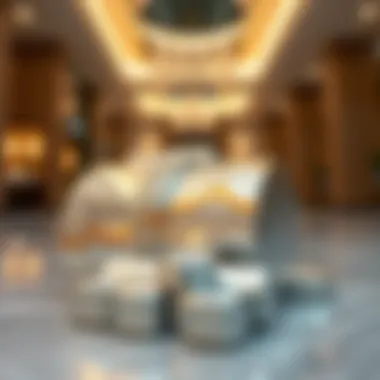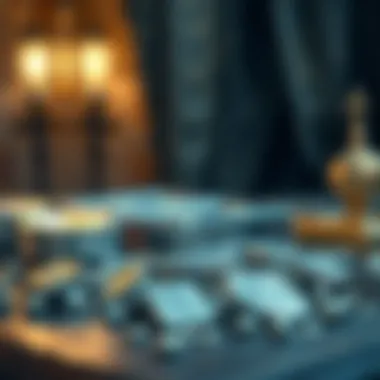Current Silver Rates and Trends in UAE Market


Intro
Silver has been a cornerstone of wealth and investment for centuries. In the UAE, with its bustling markets and dynamic economy, silver's appeal continues to grow among both investors and consumers. Understanding the current silver rate in this region is pivotal, not just for making informed investment decisions but also for grasping broader economic trends that affect various sectors.
As we delve deeper into this topic, we will first outline the most current market trends and insights related to silver rates, followed by a look at the historical data that has shaped its valuation. Furthermore, we will examine the myriad factors that influence these prices, shedding light on how global and local dynamics interplay. Investors, expats, and property managers alike will find value in familiarizing themselves with these aspects, as they hold significant implications for their financial strategies.
With this foundation set, let’s explore the intricate web of silver trading in the UAE, its market dynamics, and what the fluctuating rates mean for stakeholders.
Market Trends and Insights
Latest Market Report
Currently, silver rates in the UAE exhibit a noteworthy pattern, influenced by various global movements. As of recent analysis, the price per ounce hovers around 70 AED, but this figure is subject to rapid change based on momentary market shifts. Recent market reports indicate an upward trend attributed to increasing demand from industrial sectors, particularly in electronics and renewable energy technologies.
In addition to this, investment demand has spiked as uncertainty in global financial markets pushes investors to seek refuge in precious metals. As a result, the silver market is seeing heightened activity, with many traders keeping a keen eye on geopolitical developments and economic forecasts that could sway prices.
Key Performance Indicators
To gauge the health of the silver market in the UAE, one needs to look at several key performance indicators (KPIs):
- Price Variability: Tracking daily price fluctuations helps investors make timely decisions.
- Trading Volume: Increased trading volumes often signal growing investor interest or market volatility.
- Demand from Emerging Markets: Countries such as India and China often influence silver rates through their import demands.
- Geopolitical Factors: Political stability in major producing regions or regulatory changes can have immediate effects on prices.
These indicators, when analyzed collectively, offer valuable insights into the silver market’s trajectory and potential future movements. Staying updated on these trends allows investors to respond adeptly to shifts, optimizing their investment strategy.
“Investing in silver is not just about the price. It's understanding the market dance—knowing when to step up and when to hold back.”
Overall, the current silver rate in the UAE is not merely a number; it represents a larger economic narrative. Understanding its fluctuations is essential for any investor evaluating their next moves in this vibrant market.
Understanding Silver as an Investment
Silver has long been regarded as more than just a shiny metal used for decorative purposes or daily items; it plays a key role in the world of investments. In the context of this article, understanding silver as an investment is crucial for both prospective buyers and those looking to expand their portfolios. Silver provides a hedge against economic downturns and currency fluctuations, thus attracting not only seasoned investors but also enthusiasts just beginning their journey into the world of precious metals.
Investing in silver can be particularly beneficial for those living in the UAE, a place where gold and silver have significant cultural and financial importance. Still, the myriad benefits associated with silver investment go beyond merely owning a piece of metal; it encompasses elements of liquidity, accessibility, and diversification.
Key Elements of Silver Investment:
- Liquidity: Silver is traded globally, meaning investors can quickly buy or sell their holdings without a significant impact on the market.
- Affordability: Compared to gold, silver has a lower entry price, making it accessible for a broader range of investors.
- Hedge Against Inflation: Silver often retains its value in times of economic uncertainty, ensuring investors do not lose the purchasing power of their holdings.
- Industrial Demand: Silver is not just a precious metal; it has vast applications in industries such as electronics, healthcare, and photography, driving its demand.
However, potential investors should weigh the considerations as well. Like all investments, silver carries risks; price volatility can be significant. Additionally, the market can fluctuate based on various economic conditions. Given this, it is important for investors to stay informed about trends that may shape the price of silver.
Understanding the current trends and historical context of silver will guide investors in making informed decisions. Here, we can dig deeper into two critical aspects that shape the landscape of silver investment: its historical significance and current global demand.


Silver Rates in the UAE: An Overview
Understanding the current silver rates in the UAE is crucial for investors, expats, and consumers who have a vested interest in the precious metal market. With the UAE being a significant trading hub, the price of silver can fluctuate considerably due to various local and global factors. This overview not only captures the ongoing trends but also sets the context for why silver has captured the interest of many in the region.
Silver has traditionally been a safe investment, much like its precious counterparts, gold and platinum. Its role in electronics and renewable energy also heightens its importance. The local market shows a voracious appetite for this metal, influenced by cultural practices and investment habits.
Current Price per Gram
The current price of silver per gram serves as a benchmark for both buyers and sellers in the UAE. As of now, you can expect prices to hover around 99.50, but this figures tends to vary with market dynamics. Daily fluctuations can be attributed to shifts in supply and demand, global economic conditions, and geopolitical events.
In real-world scenarios, consider how an investor might purchase silver from a local dealer or an online platform. Keep in mind that prices can include premiums based on the seller's markup, which is common in many markets. Additionally, tracking prices regularly can provide insights for making informed decisions, especially if you are planning to buy large quantities.
Daily price adjustments, investors can utilize various platforms, including financial news websites and dedicated commodity trading apps, ensuring they are always in the loop. Some popular platforms for this purpose include Kitco and Investing.com, among others.
Comparison with Historical Prices
When it comes to understanding the current price of silver, looking at historical data is essential. Over the last decade, silver prices have shown considerable volatility. Back in 2011, prices soared to an impressive 110.00 per gram, primarily due to increased investor interest during economic downturns. However, this was followed by a dip, and prices fluctuated in the 60.00 to 80.00 range for several years thereafter.
Recent trends show a gradual recovery, attributed to heightened inflation fears and an increased focus on sustainable investments. Many experts believe that as economies globally strive for greener alternatives, the demand for silver could potentially rise.
"The history of silver pricing reveals that market sentiment often dictates value more than supply itself."
The following factors should be considered when comparing current prices with historical rates:
- Global Economic Events: Major events can cause spikes in silver prices.
- Technological Advances: Innovations in solar energy and electronics drive silver demand.
- Cultural Importance: In many cultures, silver is viewed as a symbol of wealth and is often used in jewelry, impacting demand.
Understanding these trends not only provides insight into the value of silver today but also aids potential investors in making well-rounded decisions. Monitoring these shifts can help anticipate future movements, providing a more strategic approach to buying and selling in the UAE market.
Factors Influencing Silver Prices
Understanding the factors influencing silver prices is essential for investors and consumers navigating the UAE’s silver market. The value of silver doesn't merely stem from its physical properties but also from a myriad of dynamic elements affecting its supply and demand. Knowing these factors can empower investors to make informed decisions, key to optimizing their investments in this precious metal.
Global Economic Conditions
Global economic conditions have a significant bearing on silver prices. When economic uncertainty looms large, many investors seek refuge in precious metals like silver, often seen as a safe haven. Fluctuating currencies, particularly the U.S. dollar, can impact silver’s worth; when the dollar weakens, silver often sees a rise in value. Conversely, a strong dollar generally results in lower silver prices as it becomes more expensive for holders of other currencies.
Another factor is inflation. Inflation rates can destabilize economic environments, prompting investors to stock up on tangible assets, including silver. Investors’ concerns about inflation spikes can drive prices and, in times of economic downturn or instability, increase demand for this shiny metal.
According to various reports, there has been a noticeable trend of rising silver purchases during periods of economic slowdowns, with savvy investors opting for silver as a hedge against financial adversities.
Local Market Dynamics in the UAE
The UAE itself has unique market dynamics that contribute to silver pricing. Dubai, being a significant trading hub, plays a crucial role in the trading of silver across the region. Local demand fluctuates based on cultural traditions, with occasions like weddings and festivals leading to spikes in silver purchases. The ornamental use of silver in jewelry also drives up demand locally, while economic factors, like new regulations or tax changes, might affect pricing as well.


Moreover, the presence of large trading companies and marketplaces in Dubai adds a layer of complexity to the silver market. Often, these entities influence price listings, and their buying habits can signal broader trends in the market.
Investment Trends Affecting Demand
Investment trends are continuously evolving, and they hold sway over the demand for silver. In recent years, there's been a growing interest in sustainable and ethical investing. This shift influences how and why investors choose silver; more folks are beginning to see it not just as a metal, but also as an investment in eco-friendly technologies like solar panels, where silver plays a vital role in the manufacturing process.
Furthermore, the rise of online trading platforms has made silver trading more accessible than ever. Retail investors now have tools at their fingertips that allow for easy buying and selling, which impacts how silver prices are set on a daily basis. Stay informed about emerging trends and news in the investment space, as they can create waves in the silver market.
In summary, the intricate interplay between global economic conditions, local market dynamics, and investment trends creates a multi-faceted landscape that influences silver prices in the UAE. Being cognizant of these factors enables investors to make more informed choices as silver continues to be a staple in both cultural and financial contexts.
Buying and Selling Silver in the UAE
The ability to efficiently buy and sell silver in the UAE is an integral part of navigating the precious metals market. Silver, while not as widely recognized as gold in investment circles, offers its own set of advantages and vulnerabilities. The market for silver, especially in the UAE, is as dynamic as the weather here; fluctuating prices can be a boon for savvy investors or a stumbling block for the unaware. Understanding the nuances of buying and selling silver can travel a long way in ensuring one makes profitable decisions.
Where to Buy Silver
When it comes to purchasing silver in the UAE, investors have a buffet of options available. This can range from local jewelers to international dealers, each providing different advantages. Understanding where to buy silver is crucial for securing competitive rates.
- Local Jewelers: Many local jewelers stock a variety of silver items, from jewelry to bullion bars. It's worth taking a stroll through the bustling markets of Deira or Karama to uncover competitive prices.
- Government Mints: Buying directly from mints like the Emirates Gold is a surefire way to guarantee authenticity. They offer silver in both coins and bars, ideal for those focused on bullion investments.
- Online Platforms: E-commerce has seeped into the precious metals space. Websites such as BullionVault and APMEX provide the convenience of buying silver from the comfort of your home. Compare prices across different platforms for the best deals.
- Auctions: Occasionally, silver can be procured at auctions where collectors are eager to part with rare pieces. Keep an eye on local auction houses in Dubai.
Remember to do your due diligence before making a purchase to assess the credibility of the seller and verify prices against current market trends.
Selling Silver: Marketplaces and Strategies
Selling silver can often be more nuanced than purchasing, as it requires knowledge of the current market conditions and where to position oneself for optimal returns. If you’ve got silver to part with, choosing the right strategy can significantly affect profitability.
- Marketplaces: Selling through local jewelers can yield quick cash, but these shops often offer lower rates than the real market price. Online platforms like eBay can potentially fetch a better price, especially for unique pieces.
- Buyback Programs: Some jewelers and special dealers offer buyback programs that guarantee a certain percentage of the original sale price. Be sure to compare offers from different dealers.
- Physical Shows and Events: Attending trade shows or local meetups for precious metal enthusiasts could open up avenues for selling silver directly to collectors. These interactions often allow for negotiating better sale prices.
- Market Timing: Timing can be everything in silver trading. Keeping an eye on the current trends and global events that influence the silver price is vital. If the market is up, it’s an opportune moment to sell.
"Price fluctuations often reveal the hidden gems in silver trading. Investors who remain informed tend to navigate market upswings and downturns with confidence."
Selling silver might also involve paying attention to the purity and weight of your items, which can significantly impact their resale value. Therefore, ensuring you do thorough research is essential before finalizing any selling decisions to assure a return worth your while.
As the silver market continues to evolve, both first-time buyers and seasoned investors can benefit from strategic buying and selling practices that align with market trends.
Silver as a Hedge Against Inflation
In today's volatile economic landscape, investors are often on the lookout for safe havens for their assets. One of the compelling options that has stood the test of time is silver. As the UAE sees fluctuations in market stability, the significance of silver as a hedge against inflation can't be overlooked. It offers not just a store of value but also acts as a safeguard against the erosion of purchasing power.
Understanding the Concept of Hedging
Hedging is like a safety net that helps protect investments from unforeseen market swings or economic downturns. When you hedge, you essentially take a position in one asset to offset potential losses in another.
In the context of silver, this means that if the value of currency declines due to inflation, the price of silver often moves inversely. So, holding silver can buffer you against rising costs in everyday goods while preserving your overall wealth. This property of silver makes it attractive to various investors who want to balance risk and return in their portfolios. More than merely a speculative asset, it provides an essential anchor in uncertain times.


Comparative Analysis with Other Assets
Comparing silver to other investment options can give a clearer picture of its unique benefits as an inflation hedge. Here are a few points to consider:
- Gold vs. Silver: While gold is often seen as the go-to asset for hedging, silver has its own flair. It's less expensive, making it more accessible for the average investor. Silver tends to have higher volatility than gold, which means there can be more potential for gains (and losses) during inflationary periods.
- Real Estate: Real estate is typically considered a safe investment against inflation, as property values often rise over time. However, it requires larger capital and involves ongoing management costs. Silver, on the other hand, is easier to buy and sell with lower transaction costs, making it a liquid asset.
- Stocks: Stocks can yield impressive returns, but they carry their own risks, especially during economic downturns. Companies may struggle and not pass on their profits to shareholders. In contrast, silver's value isn’t directly tied to corporate performance and often appreciates when economic conditions worsen.
"As inflation creeps up, holding silver can be your silent partner, watching over your purchasing power with a steady gaze, even amid market turbulence."
In summary, having silver in your investment portfolio can be a prudent move against inflation. It’s a tangible asset that can withstand times when currency values falter, making it an attractive alternative to other forms of investment like stocks or real estate. For investors in the UAE, especially, understanding these concepts will enhance decision-making, allowing for more resilient asset management.
The Future Outlook for Silver Prices in the UAE
The future of silver prices in the UAE is a topic that captures the interest of both investors and everyday consumers alike. As the global economy continues to evolve, understanding the potential direction of silver prices can guide investment decisions. The UAE, with its strategic position in the financial world, serves as a significant player in the silver market. This section focuses on several crucial elements regarding prices – from expert predictions to the inherent risks and opportunities that come with investing in this precious metal.
Expert Predictions and Market Analyses
A variety of experts, including financial analysts and economists, consistently assess the potential future landscape of silver prices. Their predictions often consider various factors, such as global economic indicators, technological advancements, and geopolitical developments. Notably, some analysts believe that burgeoning demand in sectors like renewable energy could elevate silver's value. Solar panels, for instance, depend heavily on silver for efficiency, driving up demand.
According to a recent analysis by the World Silver Survey, investments in silver exchange-traded funds (ETFs) have remained robust, indicating a positive trend. Market experts also underscore that as inflationary pressures continue, industrial and investment demand might eclipse supply, pushing prices even higher.
"In a world where inflation is a constant concern, silver's intrinsic value as a hedge cannot be overstated." – Market Analyst
Moreover, traditional markets in the Gulf region, particularly in the UAE, have showcased resilience amidst fluctuating global trends. This resilience may serve as a buffer against potential economic shocks, providing a stabilizing influence on silver prices. Keeping an eye on regional sentiment towards precious metals can offer additional insights into future pricing trends.
Potential Risks and Opportunities
While the outlook for silver may seem optimistic, potential investors should tread carefully. There are inherent risks involved that could hinder the projected growth. Among the most pressing are:
- Market Volatility: Silver prices can swing drastically due to speculative trading, making short-term predictions challenging.
- Economic Instability: Regional or global economic downturns can dampen demand.
- Inflation Concerns: Although silver is often viewed as a hedge against inflation, if inflation decreases unexpectedly, demand could fall.
Conversely, there are notable opportunities that could drive silver prices higher. Some key opportunities include:
- Technological Advancements: The innovation of silver applications in electronics and renewable energy could lead to sustained demand growth.
- Geopolitical Factors: Heightened tensions or trade disputes may drive investors towards safe-haven assets, such as silver.
- Green Investments: As more funds flow into sustainable projects, the need for silver in technology like solar panels places upward pressure on prices.
Epilogue
The conclusion of this article plays a pivotal role in encapsulating the essence of silver investment within the unique economic landscape of the UAE. By summarizing key insights gleaned from various sections, it provides clarity to investors navigating the often murky waters of precious metals trading. The importance of recognizing current silver rates in the UAE cannot be understated; it reflects not only local trends but also global market currents, which have far-reaching implications.
Final Thoughts on Silver Investment in the UAE
Investors in the UAE should remain mindful of the balance between opportunity and caution when considering silver. The precious metal continues to hold significant value, often seen as a safe haven in times of economic uncertainty. With its historical ties to finance, silver serves as a strategic asset – a mechanism for capital preservation amidst inflationary pressures. Moreover, the cultural appreciation for silver in the region enhances its liquidity, ensuring that both seasoned investors and novices can find a market willing to buy or sell.
Recommendations for Prospective Investors
For those looking to dive into silver investment in the UAE, following a few key recommendations may prove beneficial:
- Stay Informed: Regularly track silver rates through dependable financial news sources and market reports to capture fluctuations.
- Understand Market Entry Points: Identify optimal times to buy smartly, particularly when prices dip. It’s essential to establish a purchasing strategy.
- Consider Authenticity: Only buy silver from recognized dealers or certified shops to avoid counterfeit products.
- Diversify Holdings: While silver can be a sound investment, consider maintaining a diverse portfolio to hedge against market volatility.
- Consult with Experts: Engaging with financial advisors who specialize in precious metals can provide insights tailored to individual investment goals.
By wrapping up this exploration of silver rates, we create a roadmap for navigating the complexities of precious metals in the UAE's thriving economy. Knowing where to invest, when to make market moves, and how to assess personal financial readiness remain fundamental to any investor's journey.











